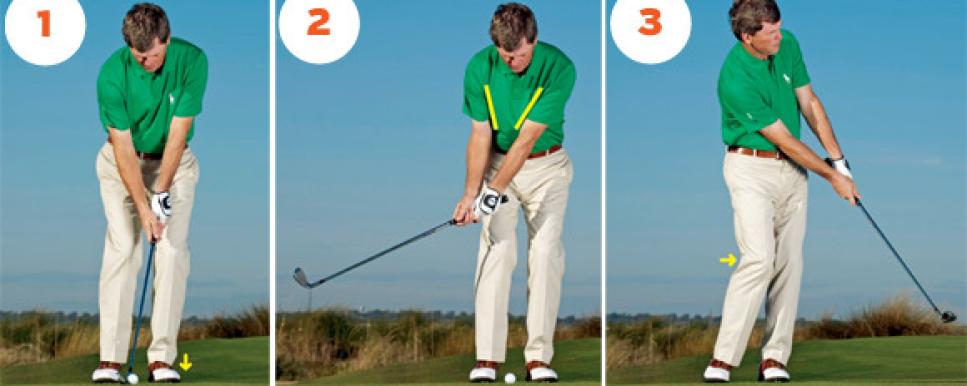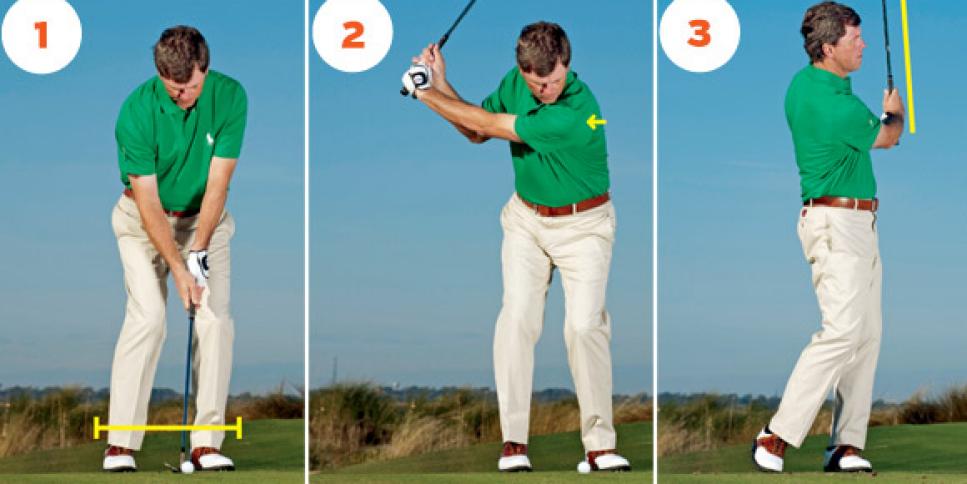Short Game
Chip. Pitch. Lob.

Want a short game to make your buddies jealous? Forget the fancy shots. Learn to hit the basic chip, pitch and lob, and then get good at picking the right one at the right time. First, here's the difference between these shots. On a chip, the clubhead stays low, below your hands on the backswing and also in the follow-through. It's a single-lever motion with no real wrist hinge. On a pitch, the clubhead goes above your hands on the backswing--because you hinge your wrists to make a longer swing--but it stays below your hands in the follow-through. On a lob, the clubhead goes above your hands on both sides of the swing--because you rehinge the club through impact to create more speed and loft. Now, here's when to use these shots. The chip runs along the ground, so you need some green to work with. The lob is great when you have to carry an obstacle and then stop the ball fast, and the pitch is for all the situations in between. Turn the page for a quick lesson on how to play these three shots.

Because the chipping swing is so short, set up with your hands and the club where you want them to be at impact. Using a short iron or wedge, play the ball just behind center, and open your stance so your lower body is pre-rotated toward the target. Set more weight on your front foot, and lean the shaft forward so your left wrist is flat (1). Swing the club back with your arms and shoulders, feeling the upper part of your arms riding on your chest as you make a little turn back. Remember, the clubhead stays below your hands (2). Don't let your right elbow jut behind you; that would mean you're moving the club with your arms only. Start the downswing with your lower body, your right knee pushing toward the target. At impact, you want to return the club to that forward-leaning position, with the shaft in line with your left arm. Keep turning your body through, and check that your left wrist is still flat at the finish (3).

With one of your wedges, take an open stance and center the ball between your heels. Avoid the common fault of tilting away from the target at address--golfers do this because they try to help the ball up. Instead, set your spine straight up and down, with the ball directly below the left side of your face (1). Start the clubhead moving first, then fold your right arm, which will cause your left wrist to hinge and the club to swing upward (2). This lengthens the swing to supply the extra speed you need on a pitch. Coming down, rotate your body through, feeling as if you maintain the hinge you created in your left wrist. Your body rotation will pull your hands and the club down and through, with your hands beating the clubhead back to the ball. Like on a chip, the shaft will be leaning forward at impact. Finish with the clubhead low and pointing left of the target (3).
LOB.

Here you need an even longer swing and an open clubface to hit the ball higher. Using your most-lofted wedge, widen your stance, open it more, and play the ball farther forward to increase the loft on the face (1). As you go back, let your wrists fully hinge, and turn your back to the target (2). The common fault here is, golfers don't make a big enough motion, so they have to overaccelerate on the downswing, leading to erratic contact. From a good backswing, the key is to let your hands and arms drop. To do this, you have to keep your grip pressure light, so you can feel the weight of the clubhead catch up with your left arm. The follow-through is a continuation of that move: The momentum of the swing rehinges your wrists, with the shaft getting to a vertical position, and your body rotates through to face the target (3).
TODD ANDERSON, ranked by his peers as one of Golf Digest's 50 Best Teachers, is the director of instruction at Sea Island Golf Club, in St. Simons Island, Ga. He is the 2010 PGA Teacher of the Year.

